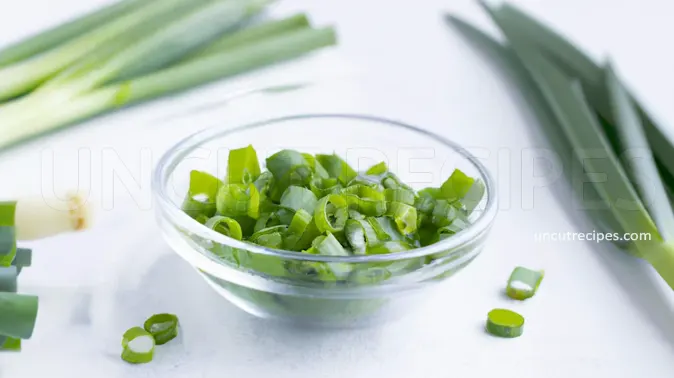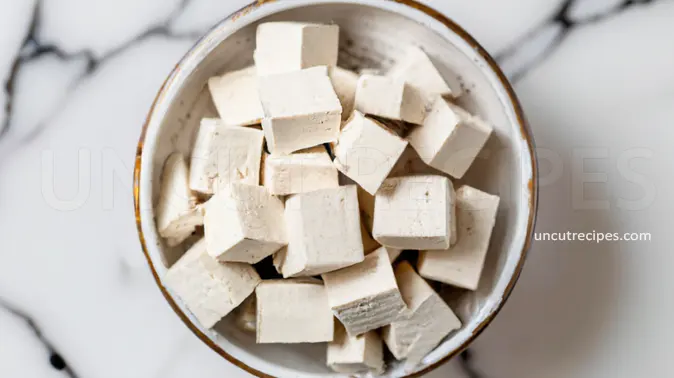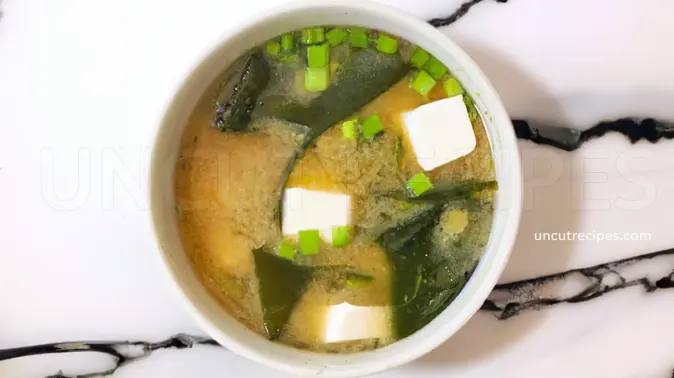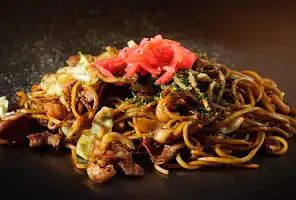My hubby is a big fan of miso soup, so I got the ingredients from a nearby Japanese shop. We enjoyed it so much, and he wants me to make it again.

Miso Soup, a dish that transcends time and geography, bringing a comforting familiarity to dining tables worldwide. It's a daily treasure in Japan, enjoyed from breakfast to dinner, and its appeal is universal.
Now, you may be wondering, what's the charm of this seemingly simple soup? The answer lies in its essence – a delicate balance of ingredients that symbolizes Japanese philosophy and culinary tradition. Miso Soup is not just about the taste; it's a way of life, a practice of mindfulness, and a connection to a rich cultural heritage.
At the core of this dish is the Dashi broth, infused with Kombu (dried kelp), carefully crafted to create a taste that's pure and unadulterated. Add to it the Miso Paste's depth, the Soft Silken Tofu's subtleness, the Wakame Seaweed's texture, and the fresh pop of Green Onions, and you have a culinary masterpiece.
This recipe invites you into the world of authentic Japanese cooking, where each ingredient is respected, and every step is a dance of precision. Whether you're cooking for yourself on a quiet evening or preparing a meal for friends and family, this Homemade Miso Soup adds a touch of grace and warmth.
So why not take a culinary detour and explore the magic of Miso Soup right in your kitchen? Here's your chance to embrace a timeless classic that's more than just a dish – it's a celebration of flavors, simplicity, and the joy of homemade cooking. Enjoy!
JUMP TO:
INGREDIENTS:
Selecting Katsuobushi: Katsuobushi, or bonito flakes, are key to the umami flavor of the miso soup. It's used to make the dashi (stock). Opt for high-quality Katsuobushi with a strong aroma and pinkish hue, avoiding any that looks grayish or dull. If needed, you can replace it with other types of dried fish flakes or even vegan alternatives like shiitake mushrooms, though the flavor profile will change.
Choosing Kombu: Kombu is a type of kelp used alongside Katsuobushi to prepare the dashi. Brands that are sourced directly from Hokkaido, Japan, are considered high quality. Look for kombu that is thick, shiny, and has white powdery substances on the surface. This white powder contains natural glutamate, enhancing the flavor. If unavailable, you can substitute it with dried kelp or seaweed, but make sure it's suitable for making broth.
Picking Soft Silken Tofu: The soft silken tofu adds a delicate texture to the soup. It should be smooth, without any cracks or discoloration. Be sure to select a variety marked as 'silken' rather than 'firm' or 'extra firm', as they have different textures. If tofu isn’t your preference, you can replace it with ingredients like mushrooms or thinly sliced vegetables.
Choosing Miso Paste: Miso paste is the heart of miso soup, and its flavor can vary widely based on the type of miso and its fermentation time. Generally, white miso (shiro miso) is milder and sweeter, while red miso (aka miso) is saltier and more intense. For a balanced flavor, you may want to start with white miso and adjust according to taste. If you need a gluten-free option, ensure that the miso paste doesn't contain barley or wheat.

Selecting Dried Wakame Seaweed: Wakame seaweed adds both flavor and texture to the soup. When selecting dried wakame, look for a deep green color and ensure it's free from any impurities. You can substitute it with other edible seaweeds, though the flavor and texture may differ.
MAIN STEPS:
Kombu Heating Technique: The slow heating of kombu in water is crucial for extracting its umami flavors. Rushing this process or boiling the kombu can result in a bitter taste. It's important to keep the heat at medium-low and remove the kombu just before the water boils.
Miso Paste Integration: Properly integrating miso paste is vital to achieving a smooth and flavorful broth. Dissolving the miso in a ladle with some hot broth before adding it to the pan can prevent lumps. The chosen miso's flavor profile should match the desired soup intensity, so the selection of a particular type of miso (red, white, or mixed) can be critical.
Tofu Cutting and Handling: The soft silken tofu used in this recipe can easily break apart. Gentle handling and cutting into appropriate sizes (3.3cm-1.3cm / 1.3-0.5in) ensure that it maintains its shape and texture in the soup. Adding it too early or stirring roughly can cause it to disintegrate.
Wakame Rehydration: The dried wakame seaweed will expand as it rehydrates. Adding too much can overwhelm the soup, so precise measurement is key. If the wakame is not pre-cut, cutting it to the desired size before adding it to the pot can provide better control over texture.
Avoiding Overheating: Miso soup's flavors can be altered by boiling, especially after the miso paste is added. A gentle reheating process ensures that the delicate taste of the miso remains intact. Monitoring the temperature and avoiding a rolling boil is essential for preserving the authentic flavor.
Green Onion Garnish Timing: Adding the green onion at the last moment helps retain its fresh, sharp taste. Chilling it beforehand and sprinkling it just before serving ensures that it adds both color and a crisp, fresh contrast to the warm, savory soup.
SERVED WITH:
Starter: Sunomono (Japan): A tangy vinegar salad usually made with cucumber and sometimes seafood like shrimp or crab. Its refreshing taste complements the savory flavor of miso soup.
Main Course: Teriyaki Salmon (Japan): A succulent salmon filet marinated in teriyaki sauce and grilled to perfection. This dish pairs well with miso soup due to the harmonious flavors in Japanese cuisine.
Side Dish: Steamed Jasmine Rice (Thailand): A staple in many Asian meals, steamed jasmine rice has a delicate flavor and texture that can complement the richness of miso soup.
Main Course: Bibimbap (South Korea): A mixed rice dish with vegetables, chili paste, and often meat or tofu. Its complex flavors can provide a contrast to the simple, soothing taste of miso soup.
Side Dish: Sautéed Bok Choy with Garlic (China): The mild flavor of bok choy sautéed with garlic pairs well with miso soup, adding a touch of zest without overpowering the soup.
Drink: Genmaicha Tea (Japan): A blend of green tea with roasted brown rice. This traditional Japanese tea is often served with meals, and its toasty flavor complements the umami-rich miso soup.
ALTERNATIVES:
Starter: Tofu and Seaweed Salad (China): This salad combines silken tofu with seaweed, often dressed in soy sauce and sesame oil. It echoes the ingredients of miso soup and provides a refreshing start to a meal.
Main Course: Tofu Stir-Fry with Vegetables (Thailand): Stir-frying tofu with vegetables in soy sauce offers a more substantial dish while retaining the comforting flavors familiar to miso soup lovers.
Starter: Soybean Sprout Soup (South Korea): Made with soybean sprouts, garlic, and sesame oil, this Korean soup shares the soybean component with miso soup and offers a unique and hearty flavor.
Side Dish: Wakame Seaweed Salad (Japan): A simple yet flavorful dish made from wakame seaweed, often used in miso soup, combined with cucumber and dressed with vinegar and soy sauce.
Soup: Hot and Sour Soup with Tofu (China): This Chinese soup brings together tofu, bamboo shoots, and a tangy, spicy broth. While distinct in taste, it shares the tofu ingredient with miso soup and offers a bold flavor experience.
Main Course: Grilled Miso-marinated Fish (Japan): Marinating fish in miso paste and then grilling creates a rich, savory main course. It takes the miso element of the soup and transforms it into a flavorful entrée.
HISTORY:
Miso Soup is an integral part of Japanese culinary history and culture, with a heritage that traces back over a thousand years. Its simple yet profound flavors offer a window into the Japanese way of life and culinary philosophy.
Miso Soup's origins are closely tied to the history of miso paste, a fermented blend of soybeans, salt, and a specific type of mold. Miso itself likely came to Japan from China around the 7th century, during the Asuka period. The Chinese version eventually evolved into the distinctively Japanese form of miso, with different regions of Japan developing their own particular styles and flavors.
Miso Soup holds a special place in Japanese culture. It's consumed daily by many Japanese people, often as a part of traditional breakfast. The soup's essential components, such as tofu, seaweed, and dashi (a stock made from kelp and bonito flakes), each carry their own symbolism. Tofu represents humility, and seaweed is associated with happiness and prosperity. Dashi, with its umami-rich flavor, serves as the foundation for many Japanese dishes and represents the essence of the country's cuisine.
In certain Shinto rituals, miso soup has been offered to the gods, underlining its spiritual significance. It's also considered a symbol of good health and longevity.
Throughout its history, miso soup has seen many regional variations. Different types of miso paste are used across the country, leading to diverse flavors and consistencies. Ingredients like local vegetables, fish, or clams might be added depending on the region, reflecting the natural produce available in various parts of Japan.
Today, Miso Soup continues to be a vital part of Japanese cuisine. Its preparation and enjoyment are not just about nourishment but also about understanding a philosophy that values seasonality, simplicity, and attention to detail.
Though modernization has introduced instant miso soup packets, the traditional way of making miso soup at home still thrives. The act of creating this soup from scratch is seen as a mindful practice that connects the cook with Japanese culinary traditions.
TIPS:
Choosing the Right Miso Paste: There are different types of miso, each with distinct flavors. Experimenting with combinations like white miso (Shiro Miso) for sweetness and red miso (Aka Miso) for depth can lead to a unique taste profile.
Perfecting Dashi Stock: Beyond Kombu, consider using bonito flakes or dried shiitake mushrooms in your dashi. Control the extraction time carefully; the key to unlocking the deep umami flavor is a gentle simmer.
Rehydrating Wakame: To add an extra layer of flavor, you could rehydrate the dried wakame in cold dashi instead of water. This ensures that the wakame absorbs even more umami flavor.
Tofu Technique: Freezing and thawing the tofu before cutting it can give it a more interesting texture. The freezing creates ice crystals that result in a spongy texture when thawed, which helps the tofu absorb more of the miso broth.
Adding Aromatics: Infuse oils with ginger, garlic, or lemongrass, and use this aromatic oil to sauté the miso paste before adding the dashi. This can add an aromatic dimension to the soup.
Serving Style: Serve in traditional Japanese lacquer bowls, preheated, to ensure that the soup stays at the perfect temperature from the kitchen to the table.
Garnishing Gourmet Style: Instead of regular green onions, consider garnishing with finely sliced leeks, chive blossoms, or even edible flowers. Microgreens are another gourmet touch.
Texture Play: Consider adding other textures to the soup, such as crispy fried shallots, a dollop of yuzu kosho for a spicy citrus kick, or a sprinkle of toasted sesame seeds.
Temperature Control: Be mindful of the temperature at all times. Miso has live cultures that can be killed by boiling. Using a thermometer to make sure the temperature stays below 85°C (185°F) will preserve the integrity of the miso.
Customized Flavorings: Offering guests a selection of condiments such as chili oil, ponzu sauce, or extra miso on the side allows them to tailor the flavor to their liking.
Pairing with Sake or Tea: Elevate the dining experience by pairing the miso soup with a carefully selected sake or green tea that complements the umami flavors.
Utilizing Kombu Again: Instead of discarding the used Kombu, simmer it in soy sauce, mirin, and sugar to make "tsukudani." It can be served as a side dish, providing a zero-waste approach.
Consideration for Storing and Making Ahead: Miso soup can be prepared in advance up to the point of adding miso paste and then refrigerated. This method preserves the delicate flavors and allows for quick final preparation. When ready to serve, reheat the dashi base gently, then add miso, tofu, wakame, and other ingredients, taking care not to boil.
Emphasis on Quality Ingredients: Source high-quality ingredients for a profound impact on the final flavor. Artisan miso paste, freshly harvested seaweed, and locally made tofu can significantly elevate the dish. Additionally, using filtered or spring water for the dashi can ensure that no unwanted flavors interfere with the delicate balance of the soup.
Recipe Information
Skill Level
|
Time 20 Minutes |
Price
|
Serves 1 to 8 People |
| Healthiness |
Nutritional Information |
| Ratings (Add Rating & Review) |
Reviews 21 Reviews |
Ingredients:
-
For the Dashi:
4 cups Water
1 cup Katsuobushi
( Dried Bonito Flakes )
1 piece Kombu
( Dried Kelp; 10g / 0.35oz per piece; 10x10cm / 4x4in )
For the Miso Soup:
1 regular brick of Soft Silken Tofu
( Kinugoshi Tofu )
4.5 tablespoons Miso Paste
1 Green Onion
( Scallion )
1 tablespoon Dried Wakame Seaweed
Allergens
| Fish | Gluten | Molluscs | Soy |
Directions:
01 - Grab 1 Green Onion/Scallion and chop it into thin little rounds. Put these in a bowl, cover with cling film, and put them in the fridge. We'll use them later.

For the Dashi:
02 - Begin the Broth: In a medium saucepan, combine Water with 1 piece of Kombu (dried kelp). This kelp is the secret ingredient for the flavorful base.
03 - Turn on the heat to medium-low and slowly bring the mixture to a boil. This may take about 10 minutes. Going slowly allows the flavors to develop and extracts the umami (savory taste) from the Kombu.

04 - Remove the Kombu: Just before it boils, take the Kombu out of the pan. You can save it for another recipe if you like. What's left in your pan is called Kombu Dashi, a tasty broth ( see Notes ).

For the Miso Soup:
05 - Add the Kombu Dashi (broth) to the saucepan. This will form the base of your soup ( see Notes ).
06 - Next, mix in the Miso Paste. Stir well until it's completely dissolved in the soup. This gives the soup its characteristic flavor.

07 - Cut the Soft/Silken Tofu ( Kinugoshi Tofu ) into 1.3 / 0.5in, and gently add them to the miso soup, allowing them to heat through.

08 - Sprinkle the Dried Wakame Seaweed into the pot. These will expand and soften as they heat, adding texture and flavor to the soup.
09 - Gently reheat the miso soup, ensuring it gets hot but does not boil, as boiling could change the delicate flavors.

10 - Finally, take the chopped Green Onions from the refrigerator and scatter them over the soup just before serving. This adds a fresh, vibrant touch. Serve the soup hot, and savor the delicious, traditional flavors. Enjoy!

Notes:
For the Dashi: Dashi Base (For the Kombu): Never wash the kombu, and do not remove the white substance, as that contains umami flavor. Just check for dirt particles.
Vegetarian/Vegan Options for Dashi: The Kombu can be used to make Kombu Dashi for vegetarians/vegans.
For Non-Vegetarians: If you're not vegetarian/vegan, add 1 cup katsuobushi to the kombu dashi, bring it back to a boil, and strain.
Storing the Dashi: You can store the dashi in the refrigerator for up to 3–5 days and in the freezer for up to 2 weeks.
Reuse the Katsuoboshi: Reserve the spent katsuobushi; it could be used for Simmered Kombu (Kombu Tsukudani) or Homemade Furikake (Rice Seasoning).
For The Miso: Different types of miso paste (white, red, or mixed) will give the soup various flavors and colors. If using Dashi from the refrigerator, bring it to simmer before turning off the heat.
Tofu Handling: Use soft silken tofu for a delicate texture or firm tofu for a firmer texture. Add the tofu after the miso is completely dissolved to avoid breaking it.
Wakame Seaweed: If dried Wakame is unavailable, use fresh Wakame but adjust the quantity since dried Wakame expands significantly.
Garnish Alternatives: Consider adding traditional garnishes like sliced Shiitake mushrooms or small clams to enhance the flavor.
Heat Control: Never boil the miso soup, as it loses nutrients, flavor, and aroma. Maintain a low to medium heat throughout cooking.
Storage of Soup: Miso soup can be stored in the refrigerator for up to two days. Reheat gently without boiling.
Authentic Ingredients: Source authentic Japanese ingredients from specialty stores or online for the most traditional flavor profile.
Serving Ware: Enhance the authenticity by serving the soup in traditional miso soup bowls.
Adding Protein: Cooked and sliced chicken or shrimp can be added for a more substantial meal.
Hydration of Wakame: If the Wakame does not soften as desired, pre-soak it in water before adding it to the soup.
Nutritional Information
( Per Portion )
|
Calories |
150 kcal (8%) |
| Total Carbohydrate | 13g (4%) |
| Cholesterol | 5mg (2%) |
|
Total Fat |
7g (11%) |
| Saturated Fat | 1.5g (7%) |
| Polyunsaturated Fat | 2g |
| Monounsaturated Fat | 1g |
| Trans Fat | 0g |
| Fibers | 2g (8%) |
| Protein | 10g (20%) |
| Sugar | 4g (16%) |
|
Vitamin A |
200 IU (4%) |
|
Vitamin B1 (Thiamin) |
0.1mg (7%) |
| Vitamin B2 (Riboflavin) | 0.1mg (8%) |
| Vitamin B3 (Niacin) | 2mg (10%) |
| Vitamin B5 (Pantothenic Acid) | 0.5mg (10%) |
| Vitamin B6 | 0.2mg (10%) |
| Vitamin B7 (Biotin) | 5mcg (17%) |
| Vitamin B9 (Folate) | 30mcg (8%) |
| Vitamin B12 | 0.5mcg (8%) |
| Vitamin C | 2mg (3%) |
| Vitamin D | 0 IU (0%) |
| Vitamin E | 1mg (5%) |
| Vitamin K | 10mcg (8%) |
| Choline | 30mg (5%) |
| Carnitine | 5mg |
|
Calcium |
150mg (15%) |
|
Chloride |
100mg (2%) |
| Chromium | 12mcg (10%) |
| Copper | 0.1mg (10%) |
| Fluoride | 0.2mcg |
| Iodine | 50mcg (33%) |
| Iron | 2mg (11%) |
| Magnesium | 40mg (10%) |
| Manganese | 0.5mg (20%) |
| Molybdenum | 15mcg (20%) |
| Phosphorus | 100mg (8%) |
| Potassium | 400mg (9%) |
| Selenium | 15mcg (27%) |
| Sodium | 1000mg (43%) |
| Sulfur | 90mg |
| Zink | 2mg (18%) |
* Percent Daily Values are based on a 2,000 calorie diet. Your daily values may be higher or lower depending on your calorie needs.
** Nutrient information is available for all ingredients in this recipe. Amount is based on available nutrient data collected from all over the internet.
(-) Information is not currently available for this nutrient. If you are following a medically restrictive diet, please consult your doctor or registered dietitian before preparing this recipe for personal consumption. |
| Written by: Uncut Recipes | Disclaimer |














August 09, 2023
Wow, the taste of this miso soup was amazing! I made it for my family, and they all said it was great. A new favorite for sure.